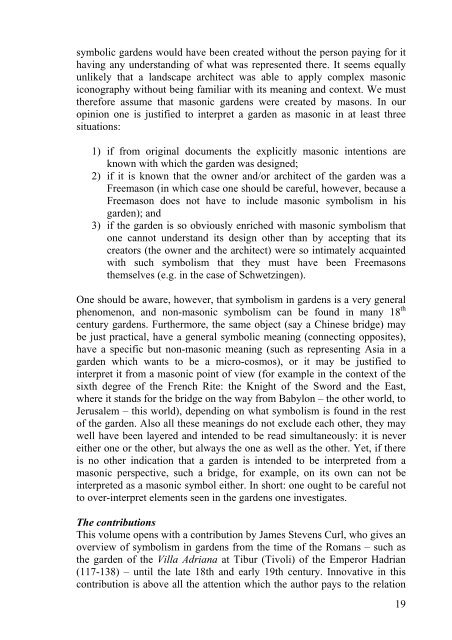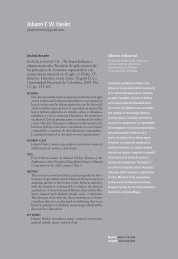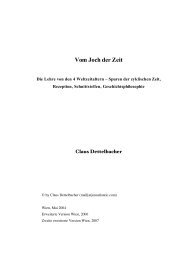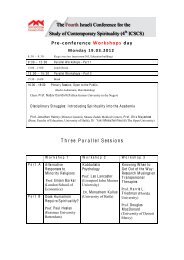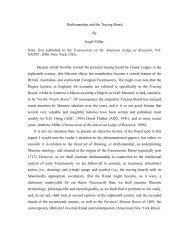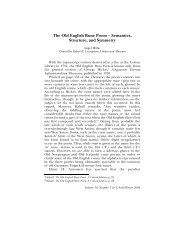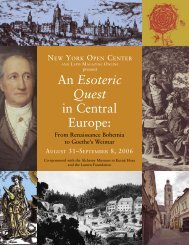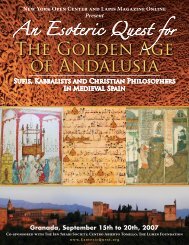Material for the introduction - Stichting OVN
Material for the introduction - Stichting OVN
Material for the introduction - Stichting OVN
Create successful ePaper yourself
Turn your PDF publications into a flip-book with our unique Google optimized e-Paper software.
symbolic gardens would have been created without <strong>the</strong> person paying <strong>for</strong> it<br />
having any understanding of what was represented <strong>the</strong>re. It seems equally<br />
unlikely that a landscape architect was able to apply complex masonic<br />
iconography without being familiar with its meaning and context. We must<br />
<strong>the</strong>re<strong>for</strong>e assume that masonic gardens were created by masons. In our<br />
opinion one is justified to interpret a garden as masonic in at least three<br />
situations:<br />
1) if from original documents <strong>the</strong> explicitly masonic intentions are<br />
known with which <strong>the</strong> garden was designed;<br />
2) if it is known that <strong>the</strong> owner and/or architect of <strong>the</strong> garden was a<br />
Freemason (in which case one should be careful, however, because a<br />
Freemason does not have to include masonic symbolism in his<br />
garden); and<br />
3) if <strong>the</strong> garden is so obviously enriched with masonic symbolism that<br />
one cannot understand its design o<strong>the</strong>r than by accepting that its<br />
creators (<strong>the</strong> owner and <strong>the</strong> architect) were so intimately acquainted<br />
with such symbolism that <strong>the</strong>y must have been Freemasons<br />
<strong>the</strong>mselves (e.g. in <strong>the</strong> case of Schwetzingen).<br />
One should be aware, however, that symbolism in gardens is a very general<br />
phenomenon, and non-masonic symbolism can be found in many 18 th<br />
century gardens. Fur<strong>the</strong>rmore, <strong>the</strong> same object (say a Chinese bridge) may<br />
be just practical, have a general symbolic meaning (connecting opposites),<br />
have a specific but non-masonic meaning (such as representing Asia in a<br />
garden which wants to be a micro-cosmos), or it may be justified to<br />
interpret it from a masonic point of view (<strong>for</strong> example in <strong>the</strong> context of <strong>the</strong><br />
sixth degree of <strong>the</strong> French Rite: <strong>the</strong> Knight of <strong>the</strong> Sword and <strong>the</strong> East,<br />
where it stands <strong>for</strong> <strong>the</strong> bridge on <strong>the</strong> way from Babylon – <strong>the</strong> o<strong>the</strong>r world, to<br />
Jerusalem – this world), depending on what symbolism is found in <strong>the</strong> rest<br />
of <strong>the</strong> garden. Also all <strong>the</strong>se meanings do not exclude each o<strong>the</strong>r, <strong>the</strong>y may<br />
well have been layered and intended to be read simultaneously: it is never<br />
ei<strong>the</strong>r one or <strong>the</strong> o<strong>the</strong>r, but always <strong>the</strong> one as well as <strong>the</strong> o<strong>the</strong>r. Yet, if <strong>the</strong>re<br />
is no o<strong>the</strong>r indication that a garden is intended to be interpreted from a<br />
masonic perspective, such a bridge, <strong>for</strong> example, on its own can not be<br />
interpreted as a masonic symbol ei<strong>the</strong>r. In short: one ought to be careful not<br />
to over-interpret elements seen in <strong>the</strong> gardens one investigates.<br />
The contributions<br />
This volume opens with a contribution by James Stevens Curl, who gives an<br />
overview of symbolism in gardens from <strong>the</strong> time of <strong>the</strong> Romans – such as<br />
<strong>the</strong> garden of <strong>the</strong> Villa Adriana at Tibur (Tivoli) of <strong>the</strong> Emperor Hadrian<br />
(117-138) – until <strong>the</strong> late 18th and early 19th century. Innovative in this<br />
contribution is above all <strong>the</strong> attention which <strong>the</strong> author pays to <strong>the</strong> relation<br />
19


